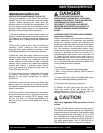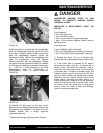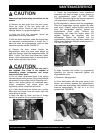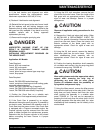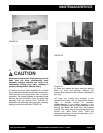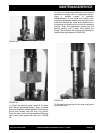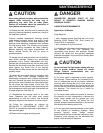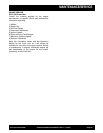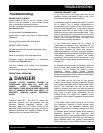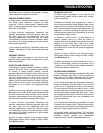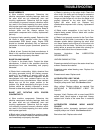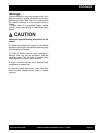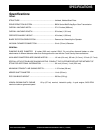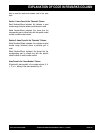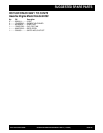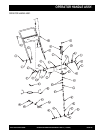
RCC130H-CRACK SAW OPERATION AND PARTS MANUAL REV #1 (11/18/04) PAGE 39
TROUBLESHOOTING
Troubleshooting
ENGINE FAILS TO START
Ignition switch in OFF or cut off position. Place
switch in the ON position or move throttle control
lever to the ignition operational position.
Incorrect carburetor/fuel ignition system adjustment.
See Service section.
Air filter blocked. See Service section.
Ignition wire to spark plug loose or disconnected.
Reconnect.
Fuel supply exhausted. Refill the fuel tank.
ENGINE LOSES POWER
Incorrect carburetor/fuel injection adjustment. See
Service section.
Water in fuel supply. Drain and replace fuel.
Excessive carbon accumulation in combustion
chamber. See Service section.
Fuel tank breather vent closed (if so equipped).
Open vent.
Air filter system blocked. See Service section.
OPERATIONAL PROBLEMS.
DANGER
ALWAYS UTILIZE DIAMOND BLADES IN
COMPLIANCE WITH ANSI B7.1, ANSI B7.5
AND/OR LATEST REVISION(S) AND
APPLICABLE OSHA REGULATIONS. IMPROPER
USE OF DIAMOND BLADES CAN RESULT IN
PROPERTY DAMAGE AND/OR PERSONAL
INJURY.
Copies of ANSI B7.1 and B7.5 for review and
education purposes can be obtained from the
American National Standards Institute, 1430
Broadway, New York, NY, 10018. Copies of the
applicable OSHA regulations governing the use of
powered equipment and diamond blades can be
obtained from your nearest OSHA office.
DIAMOND SEGMENT LOSS
a) The Crack Saw is not being held firmly by the
operator, causing the blade to twist or jam in the
work surface. Hold the Crack Saw firmly.
b) Overheating due to inadequate supply of coolant
(air or water). This is usually accompanied by
discolorations which appear on the blade blank in
the area of the segment loss. If wet sawing, provide
adequate water flow to both sides of the blade.
Determine that no water line blockage exists. If dry
sawing, periodically allow the blade to run out of the
saw cut for up to 20 seconds for every minute of
sawing. This will allow the blade to properly cool
before resuming sawing operations .
c) The blade blank wears thin as a result of
undercutting by abrasive fines generated by the
sawing process. The blade blank wears to a knife
edge which weakens the blank and causes a
segment to separate. If the fines are highly abrasive,
wear resistant blanks should be utilized to retard the
undercutting phenomenon. Inspect the blades
periodically during usage for this occurrence. If wet
cutting, allow for ample water to flush the fines out of
the saw cut.
d) Improper clamping action by the arbor shaft hub
body and hub flange causes the blade to flutter in
the cut or fail to support the blade in proper
alignment. Always clean foreign material
accumulations from the flange surfaces. Replace the
flanges if they become bent or deformed with factory
approved replacement parts only.
e) The blade can be too hard for the specific
material being sawed, causing excessive dullness
and segment separation due to impact loads and/or
fatigue. This occurrence can also be the direct
cause of frictional heat which can melt the brazing
filler material that secures the segments to the blade
blank. Use a proper blade specification for the
material being cut. Match the segment matrix
composition to the specific aggregate material being
sawed.
f) The blade rotation while sawing is out of round
(not concentric), resulting in direct impulse loads
being applied to the segments. Replace worn
machine components including bearings and arbor
shaft.
g) Improper blade rotational speed which produces
excessive pressure on the segments and
subsequent failure of the brazed/welded joint, blade
blank or segment itself. Determine that the blade is
being operated within the industry recommended
RPM speed range. Engine RPM should be checked



